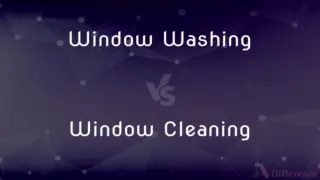Disinformant vs. Misinformant — What's the Difference?
By Fiza Rafique & Maham Liaqat — Published on March 13, 2024
A disinformant intentionally spreads false information to deceive, whereas a misinformant unknowingly shares incorrect information without malicious intent.

Difference Between Disinformant and Misinformant
Table of Contents
ADVERTISEMENT
Key Differences
A disinformant is someone who deliberately spreads false or misleading information, often with the intent to deceive, manipulate public opinion, or achieve specific goals. This deliberate act is typically done with full knowledge of the information’s falsity. In contrast, a misinformant might share incorrect or misleading information, but they do so without the intention to deceive. Their actions stem from a lack of knowledge or understanding, rather than a deliberate attempt to mislead.
The motives behind a disinformant's actions are crucial to distinguishing them from a misinformant. Disinformants often have specific agendas, such as political, financial, or personal gain, which drive them to deliberately disseminate false information. Misinformants, on the other hand, may simply be misinformed themselves and spread inaccuracies out of a mistaken belief that they are sharing truth.
The impact of disinformation can be more severe and far-reaching due to its intentional nature and the strategic planning that often accompanies it. Disinformants typically use sophisticated methods to ensure their false information reaches and influences their target audience. Misinformation spread by misinformants might also have significant consequences, but these are usually not a result of strategic intent but rather the spread of inaccuracies through social networks or word of mouth.
Identifying a disinformant requires understanding their intent and the context in which the information is being spread. This can be challenging, as disinformants often disguise their motives and may present themselves as credible sources. Identifying a misinformant, however, usually involves recognizing the accidental nature of the misinformation spread, often revealed through the individual's willingness to correct the error once presented with factual information.
Both disinformants and misinformants play roles in the spread of false information, but the distinction between them is crucial for understanding the dynamics of misinformation and disinformation in society. Addressing the harm caused by both requires different strategies: education and fact-checking may suffice for misinformants, while identifying and exposing disinformants may necessitate more complex countermeasures.
ADVERTISEMENT
Comparison Chart
Intent
Intentional dissemination of false information
Unintentional sharing of incorrect information
Motivation
Often driven by specific agendas or to deceive
Lacks malicious intent, often believes information is true
Awareness
Fully aware of the falsehoods being spread
Unaware of the inaccuracies in the information
Consequences
Can have severe, targeted impacts
Impacts are unintended and less strategic
Countermeasures
Requires exposure and strategic counteractions
Education and fact-checking can mitigate effects
Compare with Definitions
Disinformant
Aimed at manipulating or deceiving the audience.
He acted as a disinformant, spreading lies to discredit his political opponent.
Misinformant
A person who unknowingly shares false or misleading information.
The misinformant shared the article, not realizing it contained inaccuracies.
Disinformant
Uses calculated methods to ensure misinformation reaches the intended audience.
The disinformant used social media algorithms to target susceptible demographics.
Misinformant
Lacks a deliberate intent to deceive.
She became a misinformant, spreading rumors she thought were true.
Disinformant
An individual who intentionally spreads false information to deceive.
The disinformant circulated fake news stories to influence public opinion.
Misinformant
Possesses incorrect information and passes it on without malice.
As a misinformant, he apologized once he learned the facts.
Disinformant
Often motivated by political, financial, or personal objectives.
The disinformant's campaign was designed to sow discord and disrupt the election.
Misinformant
Often willing to rectify the mistake upon learning the truth.
The misinformant retracted her statement and shared the correct information.
Disinformant
Aware of the information’s falsity but chooses to spread it for gain.
Despite knowing the truth, the disinformant continued to propagate the false narrative.
Misinformant
Shares misinformation without a plan, often through casual communication.
The misinformant unintentionally spread the hoax, thinking he was helping.
Disinformant
To give disinformation to.
Misinformant
To provide with incorrect information.
Disinformant
One who disinforms.
Misinformant
One who gives wrong information; a misinformer.
Common Curiosities
What makes a disinformant different from a misinformant?
The key difference lies in intent; disinformants deliberately spread falsehoods to deceive, while misinformants unknowingly share incorrect information.
How can one identify disinformation?
Identifying disinformation often requires critical evaluation of the source, intent, and content, looking for signs of deliberate falsehoods.
Can a misinformant become a disinformant?
If a misinformant becomes aware of the falsehoods and continues to spread them with intent to deceive, they transition into a disinformant.
What impact does disinformation have on society?
Disinformation can erode trust, polarize communities, and disrupt democratic processes by spreading falsehoods and misinformation.
Can misinformation ever be spread with good intentions?
Yes, misinformants often spread misinformation believing they are helping or informing others, highlighting the importance of verifying information.
Why do people become misinformants?
People become misinformants often through a lack of information, misunderstanding, or being deceived themselves.
Is all misinformation harmful?
While not all misinformation is equally harmful, it can contribute to confusion, misinformed decisions, and erode trust.
How can one protect themselves from disinformation?
Critical thinking, verifying information through credible sources, and being cautious of sensational or unverified claims can help protect against disinformation.
What is the goal of a disinformant?
The goal is often to manipulate opinions, influence behaviors, or achieve specific objectives through deception.
How can society combat disinformation?
Combating disinformation requires a multifaceted approach, including education, fact-checking, and promoting media literacy.
Can legal action be taken against disinformants?
In some cases, legal action can be pursued, especially if the disinformation violates laws or platform policies.
What role do social media platforms play in the spread of disinformation?
Social media can amplify disinformation by enabling rapid and wide dissemination, often without sufficient checks.
How does one correct misinformation as a misinformant?
Correction involves acknowledging the mistake, retracting the false information, and sharing accurate information.
Why is intent important in distinguishing between a disinformant and a misinformant?
Intent is crucial as it reflects the individual's purpose and awareness in spreading information, impacting the approach to correction or accountability.
How do disinformants manipulate public opinion?
Through strategic dissemination of falsehoods, appealing to emotions, biases, or leveraging existing divisions to influence perceptions and actions.
Share Your Discovery

Previous Comparison
Window Washing vs. Window Cleaning
Next Comparison
Virtual Private Gateway vs. Transit GatewayAuthor Spotlight
Written by
Fiza RafiqueFiza Rafique is a skilled content writer at AskDifference.com, where she meticulously refines and enhances written pieces. Drawing from her vast editorial expertise, Fiza ensures clarity, accuracy, and precision in every article. Passionate about language, she continually seeks to elevate the quality of content for readers worldwide.
Co-written by
Maham Liaqat













































